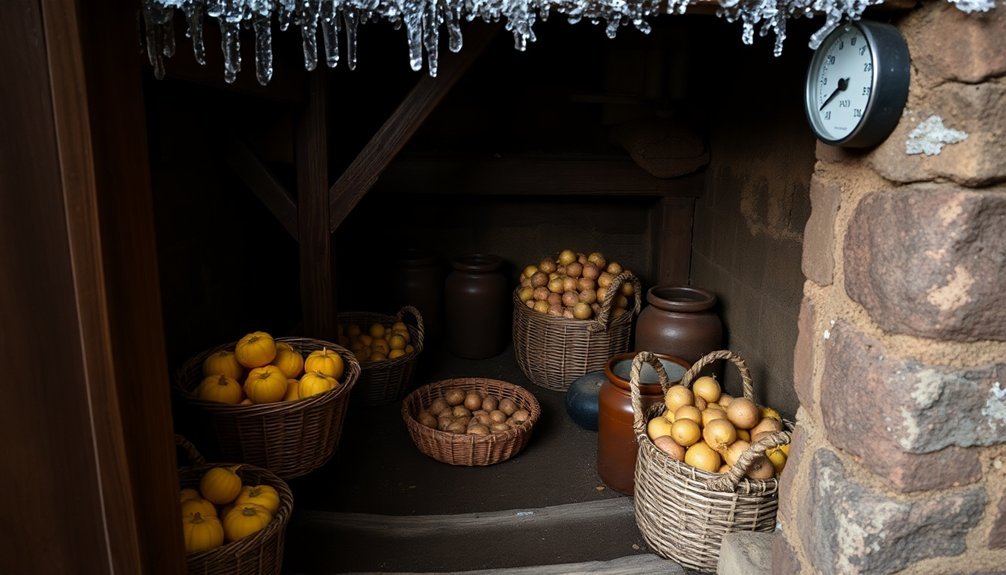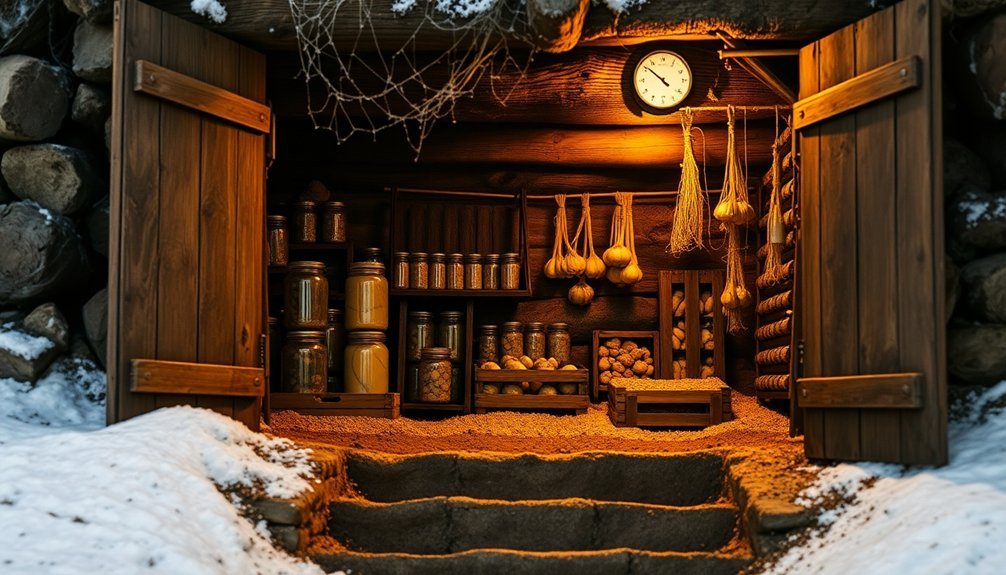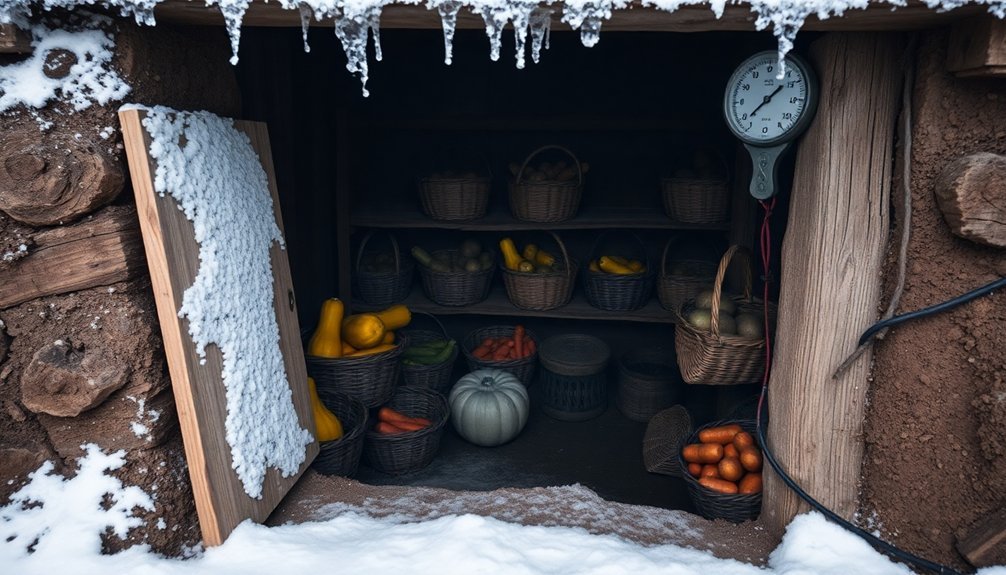Underground food storage in winter offers you a smart, natural solution for preserving your harvest. You'll benefit from the earth's consistent insulation, which maintains ideal temperatures between 32-40°F and humidity levels of 85-95%. This method protects your food from winter predators while saving energy since you won't need artificial cooling or heating. You can store root vegetables, fruits, and other produce in various underground setups like root cellars, buried containers, or converted basement spaces. The stable environment extends your food's shelf life while preserving its flavor and nutritional value. Discover how different storage options can match your specific preservation needs.
Natural Temperature and Humidity Control

Winter storage pioneers have long recognized the earth's remarkable ability to regulate temperature and humidity. When you store food underground, you'll benefit from soil's natural insulation properties that maintain temperatures just above freezing – typically between 32-35°F. This temperature range is ideal for preserving many crops through the winter months and into spring.
You'll find that underground storage provides two key advantages: stable temperatures and consistent humidity levels. The soil acts as a buffer against temperature fluctuations, while the natural moisture content helps maintain humidity levels between 90-95% for root crops like carrots and potatoes. Traditional bottomless metal drums prevent unwanted pests from accessing your stored produce.
For crops that prefer drier conditions, such as garlic and onions, you can create separate storage areas with 60-75% humidity.
The insulating effect becomes even more effective when snow covers the ground, adding an extra layer of protection. You can enhance these natural benefits by incorporating organic materials like straw or peat moss around your stored produce.
This combination of earth's natural properties and strategic storage methods creates an energy-efficient preservation system that's been reliable for generations.
Protection From Winter Predators
Underground storage keeps your food reserves safe from hungry winter predators that would otherwise dig through surface-level storage areas. When you store food beneath the soil, you'll create a natural barrier that makes it difficult for herbivores and other animals to access your supplies. The soil's stability and depth serve as effective deterrents against unwanted visitors.
You'll find that underground storage greatly reduces the visibility of your food reserves to surface-dwelling predators. Since they can't see what's stored below, they're less likely to attempt accessing it. Much like berry-bearing plants that naturally protect winter food sources, the consistent soil conditions also make it challenging for animals to dig and contaminate your stored items.
| Protection Aspect | Benefit | Impact |
|---|---|---|
| Physical Barrier | Prevents direct access | Keeps reserves intact |
| Reduced Visibility | Deters surface predators | Minimizes theft risk |
| Soil Stability | Inhibits digging attempts | Maintains food safety |
| Climate Control | Preserves food quality | Extends storage life |
This storage method guarantees your food reserves remain available for long-term use. You'll have access to these nutrients during harsh weather conditions, while predators won't be able to compromise your storage system. The stable environment helps maintain the quality of your stored items throughout winter.
Energy-Saving Storage Solutions

Natural temperature regulation makes underground storage one of the most energy-efficient solutions you'll find for preserving food through winter.
You'll benefit from the earth's thermal mass, which maintains consistent temperatures between 50°F to 62°F, eliminating the need for costly heating and cooling systems. If you're in an area with limestone deposits, you'll have an even more stable foundation for food preservation.
You can greatly reduce your energy consumption compared to above-ground storage methods. The natural limestone environment provides exceptional insulation properties that minimize energy usage.
You won't need to rely heavily on HVAC systems, as the soil acts as a natural insulator. While initial excavation costs might seem high, you'll recover these expenses through long-term energy savings and reduced maintenance costs.
Your stored food will maintain better quality thanks to consistent temperature and humidity levels.
You can customize the space with walk-in freezers and temperature-controlled areas for different preservation needs.
Plus, you'll contribute to environmental sustainability by reducing your carbon footprint and energy usage.
The underground location also helps manage stormwater runoff and preserves the landscape above, making it a practical solution that benefits both you and your community.
Preserving Fresh Food Quality
Proper food storage techniques can make or break your preservation efforts when storing items underground. To maintain ideal freshness, you'll need to carefully monitor temperature and humidity levels. Keep your storage area between 32-40°F (0-4°C) and maintain humidity between 85-95% for most produce.
You'll get the best results by matching foods to their perfect storage conditions. Root vegetables like carrots, beets, and turnips thrive in humid environments, while garlic and onions prefer drier conditions. Winter squash and potatoes do well in cool, well-ventilated spaces. If you're storing apples, they'll need higher humidity levels to stay crisp.
Your storage success depends on preventing dehydration and slowing enzymatic action that leads to spoilage. You can achieve this by using natural insulation materials like leaves or bark and monitoring conditions with thermometers and hygrometers.
When you store food properly underground, you'll extend shelf life greatly while preserving flavor and texture. This method gives you access to fresh produce throughout winter months without relying on energy-intensive refrigeration, and it's one of the safest preservation techniques you can use.
Adaptable Storage Options

Throughout the year, you'll find numerous options for adapting storage spaces to your specific needs and location. Whether you're working with a basement, garden area, or even under-bed space, you can create effective storage solutions for your harvested crops.
You can transform your basement into a root cellar, even if your home has central heating, with some creative modifications and proper investment.
For outdoor storage, you've got several practical choices. You can dig trenches or pits in your garden, using materials like wooden boxes or buried trash cans to protect your produce.
If you're looking for accessible options, try converting 5-gallon buckets into underground storage units by burying them and covering them with straw. For larger storage needs, you might consider repurposing an old chest freezer by burying it in the ground.
Don't overlook indoor spaces like closets, crawlspaces, and garages, which can work well for certain crops. You can use simple containers like Styrofoam ice chests or mesh bags to store your produce.
Even springhouses can serve as excellent root cellars, continuing their historical role in food preservation.
Frequently Asked Questions
How Deep Should an Underground Food Storage Area Be Dug?
You'll need to dig your food storage area between 3-4 meters deep for ideal temperature stability. Consider your local frost line, soil type, and climate conditions when determining the exact depth for your storage.
What Materials Are Best for Constructing Underground Storage Containers?
You'll want to use metal garbage cans or food-grade plastic drums for your underground storage. They're durable, water-resistant, and won't degrade. Make sure they're new or thoroughly cleaned before use.
How Often Should Stored Food Be Checked for Spoilage?
You'll need to check your stored food at least weekly for signs of spoilage. Look for mold, unusual odors, texture changes, and proper temperature levels. Make daily inspections if you notice any concerning changes.
Can Underground Storage Be Used in Areas With High Water Tables?
You'll face challenges with underground storage in high water table areas. You can adapt by using above-ground alternatives like mounds or raised cellars, which provide similar benefits without water infiltration problems.
What Emergency Ventilation Systems Should Be Installed in Underground Storage Spaces?
You'll need backup battery-powered fans, manual ventilation hatches, and emergency exhaust ports. Install carbon monoxide detectors and keep portable ventilators ready. These systems guarantee your safety during power outages or system failures.
In Summary
You'll find that storing food underground during winter months isn't just an old-world practice – it's a smart solution for modern food preservation. By taking advantage of the earth's natural insulation, you're protecting your harvest from freezing temperatures while maintaining ideal humidity levels. You're also saving energy, deterring pests, and ensuring your food stays fresh longer without relying on electricity.





Leave a Reply